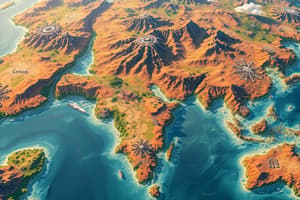Podcast
Questions and Answers
What is the primary purpose of map projections?
What is the primary purpose of map projections?
- To provide accurate distances between locations
- To create maps for navigation
- To represent the curved surface of the Earth on a 2D map (correct)
- To create aesthetically pleasing maps
Which type of map projection preserves shape?
Which type of map projection preserves shape?
- Azimuthal projections
- Equidistant projections
- Equal-area projections
- Conformal projections (correct)
What is measured by latitude?
What is measured by latitude?
- Elevation above sea level
- Distance from the Equator (correct)
- Distance from the Prime Meridian
- Distance between two points
What is the format for writing geographic coordinates?
What is the format for writing geographic coordinates?
What is the term for lines that run east-west on a map?
What is the term for lines that run east-west on a map?
Which type of projection preserves direction?
Which type of projection preserves direction?
What is the range of latitude values?
What is the range of latitude values?
What is the approximate distance equal to 1 degree of latitude?
What is the approximate distance equal to 1 degree of latitude?
What is the purpose of the Prime Meridian?
What is the purpose of the Prime Meridian?
What is the name of the system that uses latitude and longitude to locate points on the Earth's surface?
What is the name of the system that uses latitude and longitude to locate points on the Earth's surface?
What is the value of longitude at the Prime Meridian?
What is the value of longitude at the Prime Meridian?
What is the name of the imaginary line that runs around the middle of the Earth, dividing it into the Northern and Southern Hemispheres?
What is the name of the imaginary line that runs around the middle of the Earth, dividing it into the Northern and Southern Hemispheres?
Flashcards are hidden until you start studying
Study Notes
Map Projections
- A way to represent the curved surface of the Earth on a 2D map
- Methods to preserve:
- Shape: conformal projections (e.g. Mercator)
- Size: equal-area projections (e.g. Gall-Peters)
- Distance: equidistant projections
- Direction: azimuthal projections
- Common map projections:
- Mercator: preserves shape, but distorts size and distance at high latitudes
- Gall-Peters: preserves size, but distorts shape
- Azimuthal: preserves direction, but distorts shape and size
Geographic Coordinates
- System to locate points on the Earth's surface using latitude and longitude
- Latitude:
- Measures distance from the Equator (0° to 90° N or S)
- Also known as parallels
- Lines that run east-west
- Longitude:
- Measures distance from the Prime Meridian (0° to 180° E or W)
- Also known as meridians
- Lines that run north-south
- Coordinates are written in the format: latitude, longitude (e.g. 37.7749° N, 122.4194° W)
- Latitude and longitude can be measured in degrees, minutes, and seconds (e.g. 37° 46' 30" N, 122° 25' 10" W)
Map Projections
- Map projections are methods to represent the curved Earth's surface on a 2D map
- Four key properties to preserve in map projections:
- Shape
- Size
- Distance
- Direction
- Conformal projections preserve shape, but can distort size and distance
- Equal-area projections preserve size, but can distort shape
- Equidistant projections preserve distance, but can distort shape and size
- Azimuthal projections preserve direction, but can distort shape and size
Common Map Projections
- Mercator projection:
- Preserves shape
- Distorts size and distance at high latitudes
- Used for navigation, as it preserves shape and direction
- Gall-Peters projection:
- Preserves size
- Distorts shape
- Used for educational and cultural purposes, as it presents a more accurate representation of the Earth's surface
- Azimuthal projection:
- Preserves direction
- Distorts shape and size
- Used for mapping small areas, such as cities or neighborhoods
Geographic Coordinates
- Geographic coordinates are a system to locate points on the Earth's surface using latitude and longitude
- Latitude:
- Measures distance from the Equator (0° to 90° N or S)
- Also known as parallels
- Runs east-west
- Longitude:
- Measures distance from the Prime Meridian (0° to 180° E or W)
- Also known as meridians
- Runs north-south
- Coordinates are written in the format: latitude, longitude (e.g. 37.7749° N, 122.4194° W)
- Coordinates can be measured in degrees, minutes, and seconds (e.g. 37° 46' 30" N, 122° 25' 10" W)
Geographic Coordinates
- Geographic coordinates are a way to locate a point on the Earth's surface using longitude and latitude.
Latitude (φ)
- Measures distance north or south of the Equator (0° latitude).
- Ranges from 0° at the Equator to 90° at the North or South Pole.
- Latitude is divided into degrees, minutes, and seconds (e.g., 40° 26' 46" N).
- 1 degree of latitude is equal to approximately 111 kilometers (69 miles).
Longitude (λ)
- Measures distance east or west of the Prime Meridian (0° longitude).
- Ranges from 0° at the Prime Meridian to 180° east or west.
- Longitude is divided into degrees, minutes, and seconds (e.g., 74° 0' 23" W).
- 1 degree of longitude is equal to approximately 111 kilometers (69 miles) at the Equator.
Key Concepts
- Geographic coordinate system is a system that uses latitude and longitude to locate points on the Earth's surface.
- The Prime Meridian is an imaginary line that passes through Greenwich, England, and is designated as 0° longitude.
- The Equator is an imaginary line that runs around the middle of the Earth, dividing it into the Northern and Southern Hemispheres, and is designated as 0° latitude.
Studying That Suits You
Use AI to generate personalized quizzes and flashcards to suit your learning preferences.




